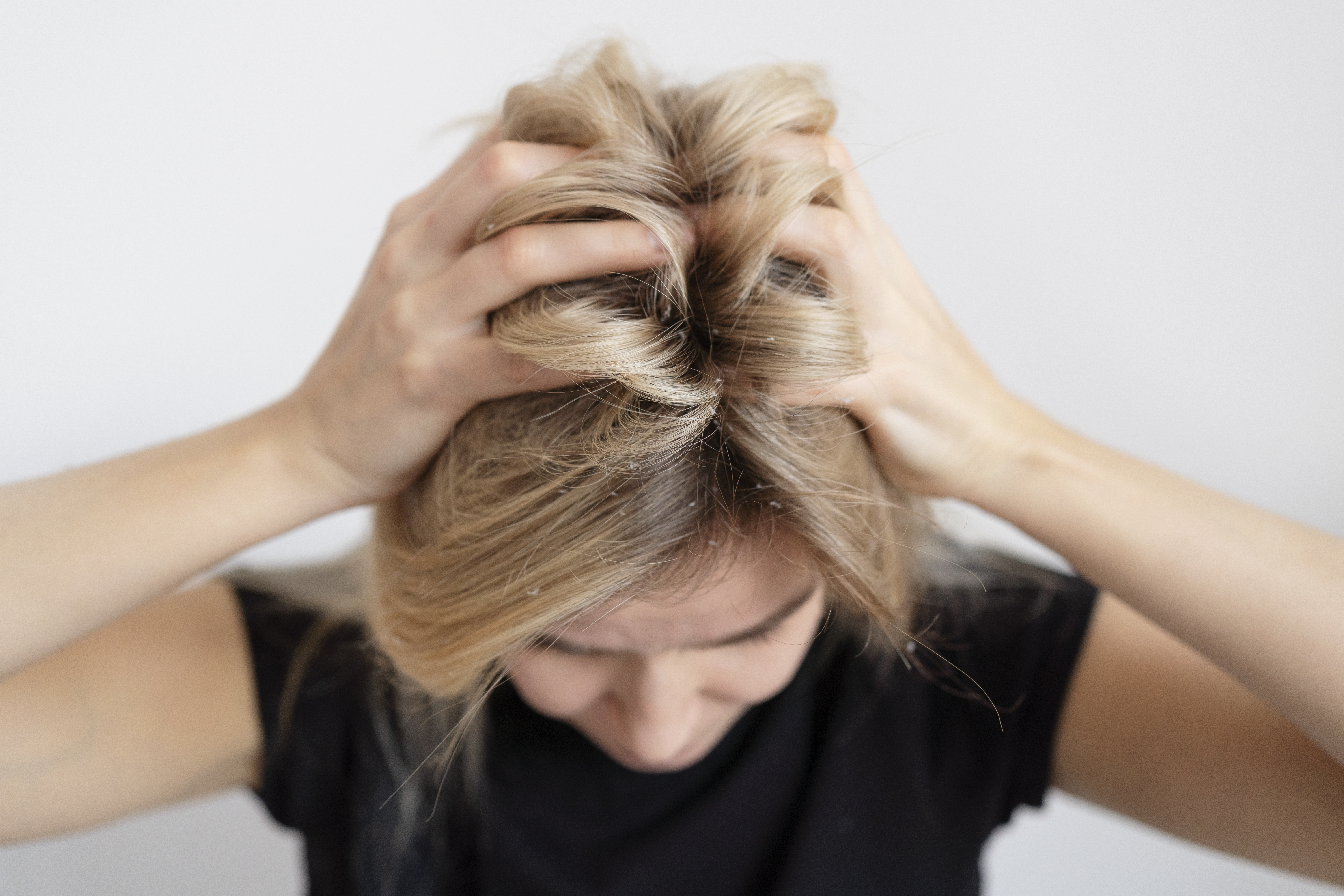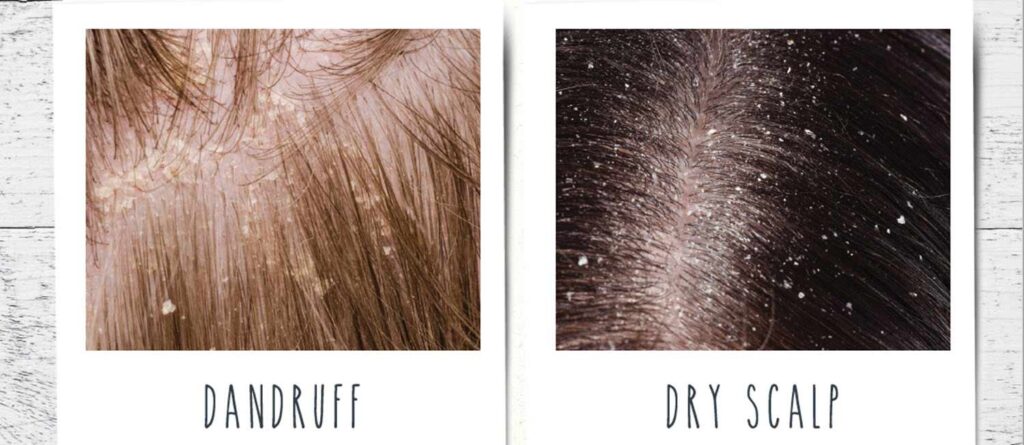Deconstructing the Misconception – Dry Scalp vs. Dandruff

Are you dealing with scalp irritation and some flakiness? Before you grab that bottle of Head & Shoulders, it’s essential to understand the difference between dry scalp and dandruff. As a haircare professional, I often encounter clients confused about the difference between dry scalp and dandruff. While these conditions may seem similar, they have distinct causes and require different treatments. Understanding these differences can help you address scalp issues more effectively.

Dry Scalp vs. Dandruff:
Dry scalp, or xerosis, occurs when the skin on the scalp lacks sufficient moisture, leading to flaking and itching. It is often a result of environmental factors, such as low humidity, frequent washing with harsh shampoos, or excessive use of heat styling tools, which can strip the scalp of its natural oils.
Dandruff, on the other hand, is a common scalp condition known as seborrheic dermatitis. It is characterized by an overgrowth of a yeast-like fungus called Malassezia, which leads to inflammation and increased skin cell turnover. This rapid turnover results in the formation of larger, greasy-looking flakes that may be white or yellowish in color.
While both conditions can cause flaking and itching, the underlying causes are different. Dry scalp is primarily due to a lack of moisture, while dandruff is linked to a specific fungus and increased oil production on the scalp. Let’s take a closer look:

Identifying Dry Scalp
Dry scalp is characterized by:
- Flaking:
The flakes from dry scalp are typically small and white, resembling dry skin. They are often more noticeable on dark clothing. - Mild Itching:
Dry scalp can be itchy, but the itching is usually mild and not accompanied by redness or inflammation. - Tightness:
Individuals with dry scalp may experience a tight or uncomfortable sensation on the scalp, especially after washing.
Identifying Dandruff
Dandruff, or seborrheic dermatitis, is characterized by:
- Larger, Oily Flakes:
Dandruff flakes are larger, oilier, and often yellow or white in color. They can be more adherent to the scalp and hair. They can also have a slight odor. - Scalp Irritation:
Dandruff is often accompanied by redness, itching, and inflammation of the scalp. - Persistent Symptoms:
Unlike dry scalp, dandruff symptoms may persist or worsen over time if left untreated.
Remedies for Dry Scalp:
- Hydrate and Moisturize:
Use a gentle, moisturizing shampoo and conditioner to keep your scalp hydrated. Look for products containing ingredients like cranberry oil, rooibos extract, soy oil, coconut oil, shea butter, or tamanu oil. These ingredients nourish and moisturize the hair, leaving it soft and hydrated. - Limit Washing:
Avoid washing your hair too frequently, as it can strip the scalp of its natural oils. Aim for 2-3 times a week instead. - Use a Humidifier:
If you live in a dry climate or during the winter months, using a humidifier in your home can help add moisture to the air and prevent your scalp from drying out. - Massage with Oil:
Massaging your scalp with natural oils like coconut, or jojoba oil can help hydrate and soothe dryness. See my article about hair oiling here.
Remedies for Dandruff:
- Antifungal Shampoos:
Look for shampoos containing active ingredients like ketoconazole, selenium sulfide, or pyrithione zinc. These ingredients can help control the growth of Malassezia, the yeast-like fungi associated with dandruff. - Botanical Alternatives:
Some shampoos offer alternatives to coal tar, such as botanical extracts like tea tree oil. These can help slow down the shedding of skin cells and reduce inflammation without the use of coal tar. - Salicylic Acid Shampoos:
Shampoos containing salicylic acid can help exfoliate the scalp and reduce flakiness, making them effective for treating mild dandruff. - Avoid Irritants:
Harsh hair products or styling treatments can irritate the scalp and worsen dandruff. Opt for gentle, scalp-friendly products instead.
It’s important to note that using dandruff treatments when you have a dry scalp can worsen dryness. If you’re unsure about your scalp condition, consult with a dermatologist or hair care professional for an accurate diagnosis and personalized treatment plan.
Can Dry Scalp and Dandruff Coexist?
Having both dry scalp and dandruff is not uncommon, as they can occur simultaneously. Treating both conditions involves a combination of strategies.
- Use a Medicated Shampoo: Look for a medicated shampoo that targets both dryness and dandruff. Choose one containing ingredients like ketoconazole, selenium sulfide, or pyrithione zinc, which can help control the fungal infection associated with dandruff while also providing moisture to the scalp.
- Moisturize Regularly: Use a moisturizing conditioner or scalp treatment to hydrate the scalp and reduce dryness. Look for products containing ingredients like coconut oil, shea butter, or glycerin, which can help hydrate the scalp without weighing down the hair.
- Avoid Over-Washing: Washing your hair too frequently can strip the scalp of its natural oils, leading to dryness. Aim to wash your hair no more than 2-3 times a week to prevent further irritation.
- Limit Heat Styling: Heat styling tools can further dry out the scalp and exacerbate dandruff. Try to limit the use of these tools and use a heat protectant spray when styling your hair.
When to See a Medical Professional: If home remedies don’t improve your scalp condition or if you experience severe itching, inflammation, or bleeding, it’s best to consult a dermatologist or healthcare provider for proper diagnosis and treatment.
Can I still get my hair done?
Individuals with both dry scalp and dandruff can still visit a hairstylist for hair treatments. As a stylist, we deal with clients with these conditions frequently, so don’t be shy to inform your stylist about your scalp condition so they can tailor the treatment and product selection to suit your needs (We’ll probably be able to tell anyway when working with your hair).
Understanding the differences between dry scalp and dandruff is key to choosing the right treatments and products to keep your scalp healthy and flake-free. By using the appropriate treatments for both conditions and adopting a consistent scalp care routine, you can effectively manage dryness and dandruff, promoting a healthier scalp and hair.


